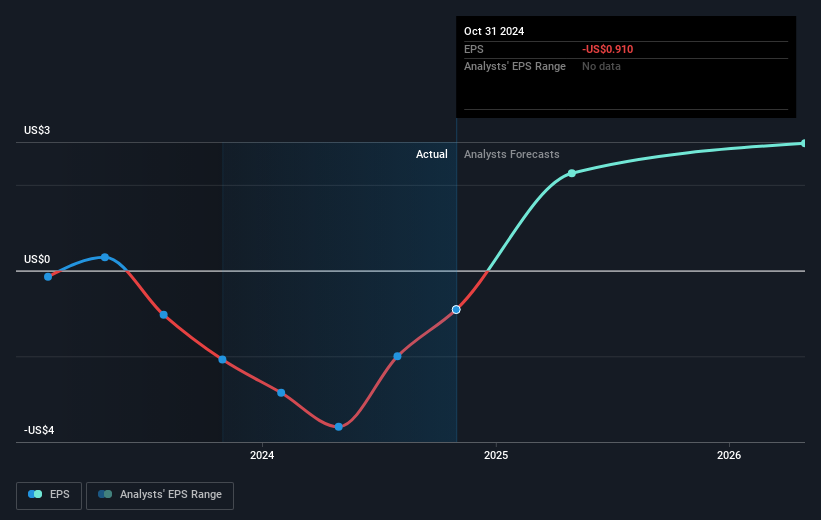- United States
- /
- Media
- /
- NYSE:WLY
John Wiley & Sons (NYSE:WLY) pulls back 3.2% this week, but still delivers shareholders notable 35% return over 1 year

It hasn't been the best quarter for John Wiley & Sons, Inc. (NYSE:WLY) shareholders, since the share price has fallen 14% in that time. But that fact in itself shouldn't obscure what are quite decent returns over the last year. Indeed the stock is up 30% over twelve months, compared to a market return of about 26%.
While the stock has fallen 3.2% this week, it's worth focusing on the longer term and seeing if the stocks historical returns have been driven by the underlying fundamentals.
Check out our latest analysis for John Wiley & Sons
To paraphrase Benjamin Graham: Over the short term the market is a voting machine, but over the long term it's a weighing machine. One way to examine how market sentiment has changed over time is to look at the interaction between a company's share price and its earnings per share (EPS).
During the last year John Wiley & Sons grew its earnings per share (EPS) by 56%. We note, however, that extraordinary items have impacted earnings. It's fair to say that the share price gain of 30% did not keep pace with the EPS growth. So it seems like the market has cooled on John Wiley & Sons, despite the growth. Interesting.
The company's earnings per share (over time) is depicted in the image below (click to see the exact numbers).

We know that John Wiley & Sons has improved its bottom line lately, but is it going to grow revenue? If you're interested, you could check this free report showing consensus revenue forecasts.
What About Dividends?
As well as measuring the share price return, investors should also consider the total shareholder return (TSR). Whereas the share price return only reflects the change in the share price, the TSR includes the value of dividends (assuming they were reinvested) and the benefit of any discounted capital raising or spin-off. So for companies that pay a generous dividend, the TSR is often a lot higher than the share price return. We note that for John Wiley & Sons the TSR over the last 1 year was 35%, which is better than the share price return mentioned above. This is largely a result of its dividend payments!
A Different Perspective
We're pleased to report that John Wiley & Sons shareholders have received a total shareholder return of 35% over one year. And that does include the dividend. That's better than the annualised return of 0.6% over half a decade, implying that the company is doing better recently. Someone with an optimistic perspective could view the recent improvement in TSR as indicating that the business itself is getting better with time. While it is well worth considering the different impacts that market conditions can have on the share price, there are other factors that are even more important. Case in point: We've spotted 2 warning signs for John Wiley & Sons you should be aware of.
If you like to buy stocks alongside management, then you might just love this free list of companies. (Hint: many of them are unnoticed AND have attractive valuation).
Please note, the market returns quoted in this article reflect the market weighted average returns of stocks that currently trade on American exchanges.
New: Manage All Your Stock Portfolios in One Place
We've created the ultimate portfolio companion for stock investors, and it's free.
• Connect an unlimited number of Portfolios and see your total in one currency
• Be alerted to new Warning Signs or Risks via email or mobile
• Track the Fair Value of your stocks
Have feedback on this article? Concerned about the content? Get in touch with us directly. Alternatively, email editorial-team (at) simplywallst.com.
This article by Simply Wall St is general in nature. We provide commentary based on historical data and analyst forecasts only using an unbiased methodology and our articles are not intended to be financial advice. It does not constitute a recommendation to buy or sell any stock, and does not take account of your objectives, or your financial situation. We aim to bring you long-term focused analysis driven by fundamental data. Note that our analysis may not factor in the latest price-sensitive company announcements or qualitative material. Simply Wall St has no position in any stocks mentioned.
About NYSE:WLY
Average dividend payer with moderate growth potential.
Similar Companies
Market Insights
Community Narratives


